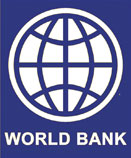'Developing countries must focus on productivity-enhancing policies'
Four years after the onset of the global financial crisis, the worst
appears to be over. However, the global economy remains fragile, as
high-income countries continue to suffer from volatility and slow
growth, stated the World Bank's latest Global Economic Prospects issued
last week.
 Despite slow growth in high-income countries, prospects for the
developing world remain solid (albeit between one and two percentage
points slower than in the pre-crisis period). Despite slow growth in high-income countries, prospects for the
developing world remain solid (albeit between one and two percentage
points slower than in the pre-crisis period).
To regain those earlier faster growth rates, developing countries
will need to focus on productivity-enhancing domestic policies, to
assure robust growth in the long term.
The World Bank estimates global GDP grew 2.3 percent in 2012. Growth
is expected to remain broadly unchanged at 2.4 percent growth in 2013,
before gradually strengthening to 3.1 percent in 2014 and 3.3 percent in
2015.
Developing countries recorded among their slowest economic growth
rates of the past decade in 2012, with GDP estimated to have grown 5.1
percent.
Growth for developing countries is projected to expand by 5.5 percent
in 2013, strengthening to 5.7 percent and 5.8 percent in 2014 and 2015.
Growth in high-income countries remains weak, with their GDP
expanding only 1.3 percent in 2012 and expected to remain slow at an
identical 1.3 percent in 2013. Growth should gradually firm to two
percent in 2014 and 2.3 percent by 2015.
In the Euro Area, growth is now projected to only return to positive
territory in 2014, with GDP expected to contract by 0.1 percent in 2013,
before edging up to 0.9 percent in 2014 and 1.4 percent in 2015.
Global trade of goods and services, which grew only 3.5 percent in
2012, is expected to accelerate, expanding by 6 percent in 2013 and 7
percent by 2015.
While diminished, downside risks to the global economy persist and
include a stalling of progress on the Euro area crisis, debt and fiscal
issues in the United States, the possibility of a sharp slowing of
investment in China, and a disruption in global oil supplies.
 In this weak external environment, growth for developing countries
will need to come from within, by strengthening governance and investing
in infrastructure, education, and health care. In this weak external environment, growth for developing countries
will need to come from within, by strengthening governance and investing
in infrastructure, education, and health care.
Regional highlights
Growth in the East Asia and Pacific region slowed to an estimated 7.5
percent in 2012, from 8.3 percent in 2011, largely due to weak external
demand and policy action in China to contain inflation.
Growth in the region, excluding China, slowed less quickly due to
robust domestic demand.
Regional GDP growth is projected to pick up to 7.9 percent in 2013
before stabilising at around 7.5 percent by 2015, with China's economy
expanding at 8.4 percent in 2013, before easing to 7.9 percent by 2015.
Ex-China, regional growth is forecast to average 5.9 percent over
2013-2015 on strong domestic demand and intensified global trade flows.
GDP growth in Europe and Central Asia is estimated to have slowed
sharply to 3 percent in 2012 from 5.5 percent in 2011 as the region
faced significant headwinds, including weak external demand,
deleveraging by European banks, summer drought and commodity-price
induced inflationary pressures.
Growth in the region is projected to rebound to 3.6 percent in 2013
and 4.3 percent by 2015. Medium-term prospects for the region will
depend critically on progress in addressing external (large current
account deficits) and domestic (large fiscal deficit, unemployment, and
inflation) imbalances, lack of competitiveness and structural
constraints.
In the Latin America and the Caribbean region GDP growth declined to
an estimated 3 percent in 2012 (from 4.3 percent in 2011) because of a
marked slowdown in domestic demand in some of the largest economies in
the region and a weak external environment.
Growth in Brazil, the region's largest economy, expanded only an
estimated 0.9 percent in 2012. A more accommodative policy environment,
stronger capital flows (notably FDI) and more robust external demand are
expected to lift regional growth over 2013-2015 to an average of 3.8
percent.
Growth in the Middle East and North Africa region continues to be
affected by political uncertainty and unrest in several countries.
Regional GDP is estimated to have grown by 3.8 percent in 2012
(following a 2.4 percent decline in 2011). Regional output is projected
to slow to 3.4 percent in 2013, rising to 4.3 percent by 2015, assuming
an easing of the current
uncertainty and domestic unrest, a strengthening of tourism, and a
recovery of the region's exports as global demand continues to firm.
In South Asia, growth weakened to an estimated 5.4 percent in 2012
(7.4 percent in 2011), mainly due to a sharp slowdown in India, where
GDP growth (measured at factor cost) is forecast at 5.4 percent in the
fiscal year ending March 2013.
Regional GDP is projected to grow by 5.7 percent in the 2013 calendar
year, and by 6.4 percent and 6.7 percent in 2014 and 2015, respectively,
driven by policy reforms in India, stronger investment activity, normal
agricultural production and improvement in export demand.
Growth in India (at factor cost) is projected at 6.4 percent in the
2013 fiscal year, rising to 7.3 percent by 2015.
Growth in Sub-Saharan Africa remained robust at 4.6 percent in 2012.
Excluding South Africa, the region's largest economy, GDP output
expanded 5.8 percent in 2012, with a third of countries in the region
growing by at least 6 percent.
Robust domestic demand, high commodity prices, increased export
volumes (due to new capacity in the natural resource sector) and steady
remittance flows supported growth in 2012. However, the expansion was
curtailed by domestic factors, including monetary policy tightening
earlier, protracted labour disputes and political unrest. The region is
projected to grow at its pre-crisis average of 5 percent during 2013-15.
Economic growth in South Asia weakened considerably in 2012 to an
estimated 5.4 percent, from 7.4 percent the previous year. Delayed
monsoon rains, electricity shortages, macroeconomic imbalances including
large fiscal deficits and high inflation and policy and security
uncertainties contributed to subdued economic activity in the region,
which also faced negative impacts from the Euro Area debt crisis and a
weak global economy.
GW
|



